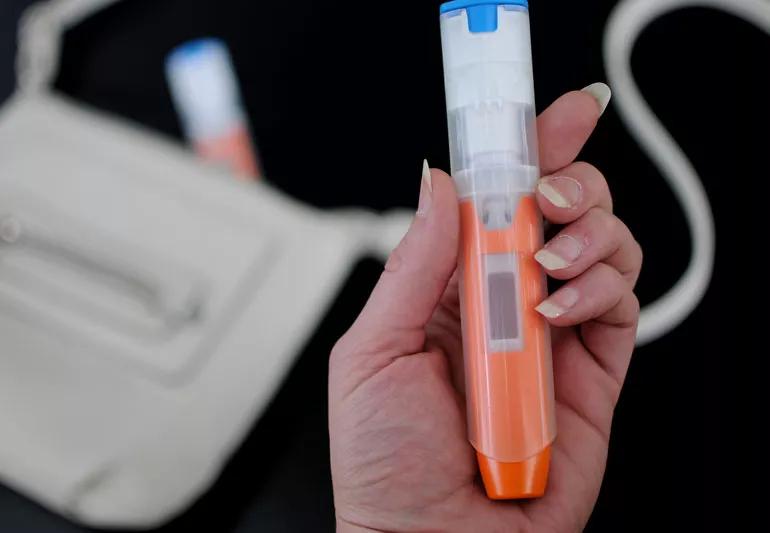EpiPens are in short supply

An EpiPen® is a lifesaver for anyone with a serious allergy. The auto-injector quickly delivers epinephrine to prevent a dangerous allergic reaction that certain foods or insect stings can trigger in you or your loved ones.
Advertisement
Cleveland Clinic is a non-profit academic medical center. Advertising on our site helps support our mission. We do not endorse non-Cleveland Clinic products or services. Policy
“You never know when a reaction will occur — and minutes can make a big difference,” says pediatric allergist Leigh Ann Kerns, MD. “Delayed delivery of epinephrine is associated with a higher risk of death.”
OK, so you always need to have an epinephrine auto-injector on hand. But currently, EpiPens are in short supply.
Also, your device may expire without your ever needing to use it. And replacing your EpiPen can be expensive.
Are there cheaper — but equally safe and effective — alternatives?
The cost of the EpiPen or EpiPen Jr. for kids is $600 or more for a twin pack containing two EpiPens and a trainer device.
Dr. Kerns notes that you can save almost half off the regular price by downloading a $300 discount coupon from Mylan, EpiPen’s manufacturer.
“They also offer a generic version priced at $300 for a twin pack — about the same price as an EpiPen with the coupon discount,” she says.
The manufacturer also offers a savings card that may cut $25 off the generic price for those with commercial insurance.
Some health insurance plans cover the cost of an EpiPen in full, so you’ll want to start by checking your plan.
Other plans negotiate a price for the EpiPen that, when combined with a coupon, covers the whole cost without any out-of-pocket expense for you, Dr. Kerns notes.
Advertisement
“Other plans negotiate a price for the Epipen that is low when used with a coupon,” she says. “However, while a coupon reduces the cost, the out-of-pocket expense for high-deductible plans can be high for families who have not yet met their deductible.”
If the cost of an EpiPen with a coupon is still too steep, and insurance won’t cover the difference, Dr. Kerns suggests asking your allergist for advice on cost-saving measures and less costly alternatives.
“Alternative devices that also contain epinephrine will keep you and your kids safe,” she says.
However, each auto-injector may dispense the medication a little differently. You can get learn more at the Food Allergy Research & Education (FARE) website.
Alternative brands to consider include:
Some injectable epinephrine devices come with a trainer, but others do not.
“The difficulty with the generic devices — even though they carry the correct medication — is that they often don’t come with a demonstrator,” Dr. Kerns says. “As a result, families sometimes are unable to practice so they know how to use them in a real emergency.”
But all companies offer training videos on their websites, she notes. And you can ask your allergist to show you how to use your device properly.
“We ask parents to show us how to use the device to make sure they’re comfortable with it,” Dr. Kerns says. “Studies have shown that when parents are more comfortable using the device, they are more likely to do so in times of need.”
Over time, Dr. Kerns noticed more and more infants with serious allergies in her practice. But babies under age 1 had no appropriate auto-injector options.
“EpiPen devices are not the appropriate dose or needle length for infants,” she explains. “Some doctors choose not to prescribe epinephrine to those families, while others prescribe it with a warning that the dose is too high,” she says. “Neither seemed like a good solution.”
So she worked with an engineer to design an alternative to the EpiPen in 2012.
Dr. Kerns now has a licensing agreement for the design, which is in development.
Advertisement
“It is a less intimidating device to use on an infant, and does not require the ‘stabbing’ delivery motion of the EpiPen,” she says.
Advertisement
Learn more about our editorial process.
Advertisement

Learn more about the signs and managing this condition

These step-by-step instructions could save a life

Most recommended precautions center around minimizing bruising or swelling

Even one drink can have an impact on your cognitive function leading to slurred speech, blurred vision and impaired memory

Understand who may (and may not) benefit

Lorem ipsum dolor sit amet. Et odio Quis vel ipsam omnis eum alias deleniti et placeat impedit non voluptas galisum hic autem enim et cupiditate aliquid. Est beatae quidem non facilis autem ut commodi nisi aut tempore rerum et dolores voluptatem cum enim optio id sapiente quasi. Ad laboriosam officiis 33 cupiditate sequi ea voluptatum consectetur qui necessitatibus voluptate et quasi doloremque et facere explicabo quo explicabo officia

Type 2 diabetes isn’t inevitable with these dietary changes

Applying a hot or cold compress can help with pain